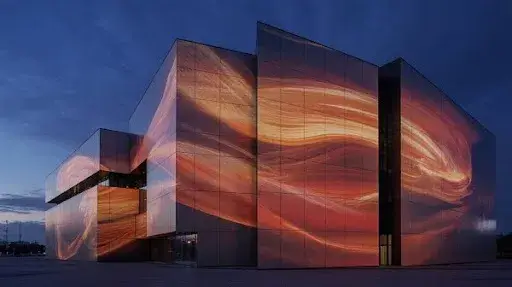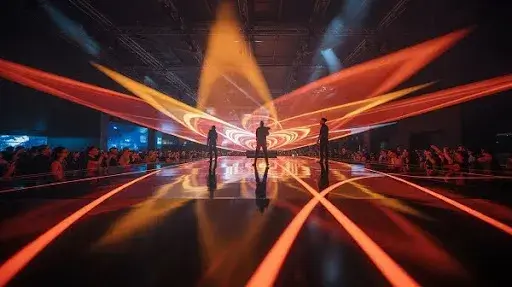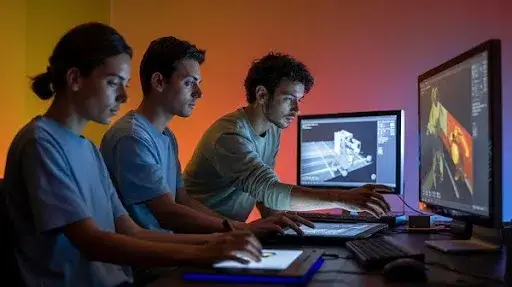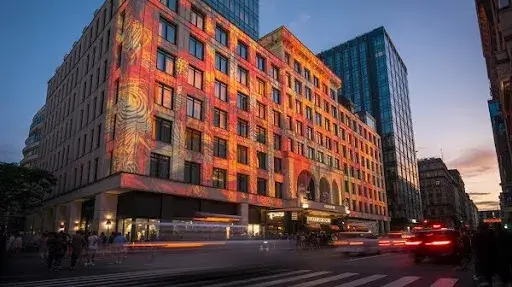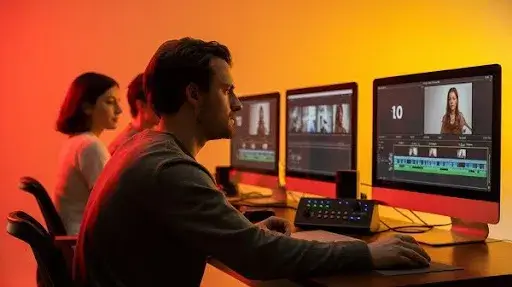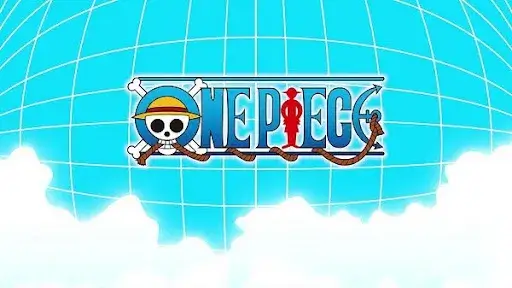The first time someone sees a building light up with moving visuals that wrap around every curve and corner, the reaction is always the same: confusion first, awe right after. It doesn’t look like a flat projection on a wall. It looks alive.
That’s the hook of 3D projection mapping, and it’s the reason brands, event planners, and production teams are pouring budget into it instead of relying only on traditional displays or static LED setups.
This technique isn’t new, but it has grown fast thanks to better projectors, advanced mapping software, and creators who know how to blend content with physical space. Companies like Prolific Studio have used these tools to create 3D projection effects that turn real objects into dynamic surfaces, without replacing the structure itself.
What Is 3D Projection Mapping?
People search what is 3D projection mapping because the results feel unreal when you see them in action. The idea is simple: use a projector to display visuals onto an object, but align the content so precisely that it fits the surface like a skin. It’s not just playing a video. It’s shaping the video around real features.
Unlike standard projection, which works on flat screens, 3D projection mapping adapts to buildings, cars, sculptures, stages, products, and any structure with form. Instead of forcing a screen into a space, the space becomes the screen.
This technique also goes by names like:
- video mapping
- architectural projection mapping
- immersive projection
- spatial projection
Some events even involve interactive projection mapping with live data, where the visuals react to movement, sound, or audience input in real time.
How Projection Mapping Works
The magic doesn’t start with the projector. It starts with understanding the physical space.
1. Scanning and Mapping Surfaces
To create a clean projection mapping installation, the team first studies the object or structure. That could mean scanning the surface, using a 3D model, or manually measuring dimensions. Irregular edges, textures, and angles matter, especially when mapping content across complex shapes.
Buildings, stage props, runway sets, cars, and custom installations all qualify as mapping surfaces. The goal is to ensure every corner of the structure lines up with what gets projected later.
2. Content Creation and Content Mapping
Once the surface is mapped, designers create visuals built for that shape. That process is known as content mapping. The content might be:
- realistic textures
- animated patterns
- branded elements
- narrative scenes
- product reveals
Studios offering professional 3D product animation videos often repurpose those assets for projection mapping. That means the 3D elements don’t just float; they connect to physical edges and forms.
3. Calibration and Setup
Projector placement makes or breaks the final result. Alignment must be exact. The projector’s angle, distance, brightness, and lens type all play roles. This is where projection mapping technology and mapping tools come in.
Creators often use software like:
- TouchDesigner
- Unreal Engine
- MadMapper
- Resolume Arena
These are considered some of the best software for projection mapping, depending on the complexity and output needs.
Once the visuals snap into place and every feature lines up, that’s when the illusion becomes convincing.
Why 3D Projection Mapping Draws Attention
Standard screens are everywhere. People scroll past them without thinking. When something wraps around a building or transforms a statue into a moving object, viewers stop. There’s novelty, but also scale and surprise.
Architectural Projection Mapping
Large-scale projection mapping on buildings is one of the most common uses. It turns landmarks into dynamic displays, not by covering them with LED panels, but by using the structure as a storytelling canvas.
Festival organizers, tourism boards, production houses, and advertisers use architectural projection mapping to:
- launch products
- mark holidays
- narrate a brand story
- create interactive attractions
- host citywide events
Projection Mapping vs LED Displays
This comparison comes up often. LED displays require physical screens, which limit flexibility. 3D projection mapping adapts to existing surfaces. It doesn’t add hardware to the structure. It also covers shapes that LED screens can’t wrap around cleanly.
LED might work better in direct sunlight or permanent installs. But for impactful, short-term, or space-specific visuals, projection mapping wins.
Applications of Projection Mapping in Events
Events use the projection mapping technique to elevate what people expect from a gathering. It’s no longer just decor and lighting. It’s a digital set design blended into reality.
Concerts and Stage Performances
Dynamic projection mapping in concerts lets performers interact with virtual scenes, moving backdrops, or sound-driven effects. Production teams use runtime projection mapping for stage design so the visuals shift with each moment in the show.
Corporate Events and Launches
Brands don’t want another slideshow. They want a reveal moment. With immersive projection, a product emerges from a surface, buildings light up with graphic animation, or a stage transforms mid-event.
Trade Shows and Installations
Companies use projection mapping installations to show how a product looks in motion, without shipping heavy gear. A car manufacturer can project designs onto a prototype. A tech company can simulate features on real walls instead of screens.
Interactive Experiences
Interactive projection mapping with live data responds to gestures, sensors, audience movement, or real-time feeds. This type of installation literally pulls people in. They don’t just look at it; they affect it.
Projection Mapping in Immersive Environments
Hotels, museums, theme parks, and sports arenas rely on projection mapping technology to build experiences that don’t need physical set changes. Walls become moving scenes. Floors pulse with visuals that track movement. Statues come to life.
When combined with AR or VR, creators can layer digital assets on top of a projection. That’s where combining projection mapping with AR/VR comes into play. The projection anchors the physical layer. The AR and VR add depth that reacts to interaction.
Real-Time Projection Mapping and Live Adjustment
Static visuals work, but real-time projection mapping shifts based on live inputs. For stage performances, that might mean syncing visuals with a performer’s movements. For events, it could tie into music or lighting.
If the environment changes, lighting, audience placement, timing, and runtime control allow adjustments without redoing everything.
What Makes Projection Mapping Attractive to Brands
Companies don’t adopt new media without a return. Applications of projection mapping in events and public activations help brands stand out in crowded advertising spaces.
Key motivations include:
- catching attention in busy environments
- delivering visuals that film well for social media
- enhancing brand identity through motion and scale
- replacing expensive set-building with projected design
- creating one-off experiences that don’t require permanent structures
Prolific Studio and similar teams often collaborate with event planners, stage designers, and agencies to create installations that mix storytelling with technical accuracy.
Challenges in Projection Mapping
The results look effortless, but the process has real obstacles:
Irregular Surfaces
Mapping content across irregular surfaces is not as easy as dropping a video onto a wall. Curves, textures, depth changes, and surface color affect clarity and distortion.
Lighting
Outdoor events face ambient light, shadows, and shifting conditions. Indoor events still need control to keep visuals crisp.
Budget and Gear
Projectors suitable for large surfaces don’t come cheap. The bigger the area, the more lumens and precision required. Rental can solve cost issues, but setup still takes a skilled team.
Software and Expertise
Not every designer knows mapping tools or advanced calibration. The wrong alignment or low-quality content weakens the impact immediately.
Mapping Tools and Software Options
Studios rely on mapping software that can handle content distortion, layering, and synchronization. Titles often mentioned in professional circles include:
- TouchDesigner for interactive performance-based visuals
- Unreal Engine for 3D environments and real-time rendering
- Resolume for live show control
- MadMapper for quick calibration and layout
Some teams combine tools to generate scenes, align content, and trigger cues. Freelancers and studios sometimes mix professional 3D product animation videos into projection sets to give depth and polish.
Prolific Studio’s Role in Projection Mapping
Prolific Studio has worked across animated content, 3D modeling, and video mapping for brands and creative teams. By aligning physical storylines with motion graphics, clients get visuals that don’t look like placeholders; they feel integrated with the structure.
From product-focused projections to architectural reveals, the studio’s approach blends animation skill with precise alignment. This matters when clients want something beyond standard LED panels or looping videos.
Where Projection Mapping Is Headed
Projection mapping isn’t just evolving in size anymore. The real shift is in how it’s being used; people want faster setups, more flexible tech, and visuals that blend with physical environments rather than sit on top of them. Studios like Prolific Studio are already tweaking how they plan and produce these projects because clients expect impact without month-long prep.
Smarter Mapping With Less Hassle
Traditionally, the slowest part of any projection job is getting the surfaces mapped. Now, scanners, lidar tools, and AI-assisted software are speeding up that step. Instead of manually guessing angles and edges, teams can auto-generate the layout and make tweaks instead of starting from scratch.
It means fewer mistakes and quicker turnarounds, especially for events that can’t afford long setup times.
Blending Projection With AR and Mixed Reality
A lot of newer installs aren’t just projections anymore. You’ll see setups where the projection covers the main structure and augmented layers appear when viewed through a phone, headset, or display screen. Museums, theme parks, and branded pop-ups love this because they can show multiple “versions” of the same space without rebuilding anything.
Smaller Surfaces, Bigger Impact
Not everything needs a castle or skyscraper to impress. Restaurants, boutiques, and event planners are mapping visuals onto bars, product displays, stage props, and even dinner tables. Short-throw projectors and compact rigs are making it easier to animate things that never would’ve been considered “screens” before.
Industries Using It Beyond the Hype
Projection mapping used to be tied to concerts and festivals, but it’s quietly spreading into sectors that aren’t trying to put on a show.
Retail and In-Store Experiences
Stores use projection to change displays without rebuilding them. Mannequins, shelves, and pop-up stands can shift themes overnight. Visuals can be reused, remixed, and scaled between locations without shipping physical props.
Training, Museums, and Education
Doctors can project organs onto models instead of using VR headsets. Museums can animate exhibits without covering them. Classrooms can turn walls into shared simulations. It’s a lot more flexible than people expect.
Hotels, Events, and Interiors
Instead of building sets or swapping decor, venues project scenes onto ceilings, floors, or furniture. A dining hall can look like three different worlds in one evening without a single renovation.
Cost, Gear, and ROI: What Actually Matters
On paper, projection mapping sounds expensive, but in a lot of cases, it replaces things that cost even more: LED panels, printed props, oversized screens, or physical sets. The variables that affect price the most are pretty consistent:
- Size and shape of the surface
- Brightness and type of projector
- Number of units involved
- Whether the content is produced from scratch or modified
- Duration of the event or installation
- Real-time elements or interaction
Even when it’s a one-time install, brands get long-term value because the footage is content gold for social media, ads, and PR.
Why It’s Not Fading Out Anytime Soon
Audiences skip ads, ignore banners, and forget half the things they see on a screen. But when a structure comes alive, or a flat space suddenly moves, people look. And more importantly, they record it.
A few reasons it keeps gaining ground:
- No need to build or install a screen
- Works on almost any surface
- Scales from small to massive
- Fits into retail, education, events, tourism, hospitality, and art
- Shoots well for social platforms
Studios like Prolific Studio already have the animation and spatial design side handled, which gives them a head start. They’re not just projecting video, they’re matching content to shape, movement, and storytelling.
Frequently Asked Questions
Is it only for big buildings?
Not anymore. People use it on sets, products, walls, sculptures, tables, cars, you name it.
Can you run it in daytime?
It works best in low light. For daytime shows, you need powerful projectors or shade.
How long does setup take?
Totally depends on the surface, gear, and content. With new scanning tools, calibration doesn’t take as long as it used to.
Can you reuse the visuals?
Yes. Designers just tweak alignment and update what’s needed.
Is it pricier than LED walls?
For permanent outdoor installs, LED might win. For staged events or irregular surfaces, projection is usually cheaper and more flexible.
Final Words
Projection mapping isn’t stuck in the novelty zone anymore. It’s turning into a go-to option for brands, educators, venues, and designers who want visuals that interact with physical space. Instead of building sets or locking people into headsets, it enhances what’s already there: walls, stages, products, and architecture.
As scanning tools and AR integrations improve, the entry cost keeps dropping. That opens the door for brands beyond the “big spenders” to use it for launches, reveals, performances, and interactive spaces.
Studios like Prolific Studio, one of the best animation studios in Chicago, will stay in demand because they’re already producing the kind of animated and spatial content that projection mapping depends on. The tech will keep evolving, but the core idea stays the same: use light, motion, and structure to create something people can’t ignore.
Related Articles:

